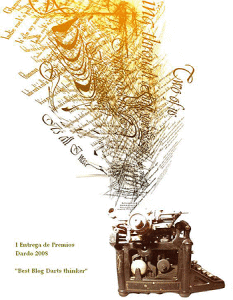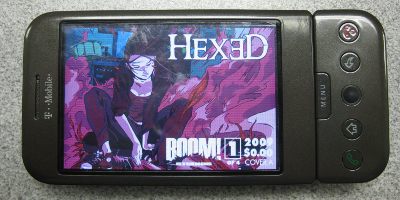The “Premio Dardo” award has been sweeping through comics blogs over the last week or two, and Groovy Superhero bestowed it upon my comics blog, Speed Force. The idea is that someone gives you the award, then you pass it along to other bloggers you appreciate.
It’s basically a chain letter or tagging meme, in the form of an award.
I was curious as to where the meme actually came from, and did some digging. I didn’t find much of anything conclusive, but I did find some interesting things:

- “Premio Dardo” means “Dart Award” in Spanish, which fits with the “I Entrega de Premios Dardo 2008” text. (This means that “Premio Dardo Award” is kind of like “La Brea Tar Pits” in that it literally means “Dart Award Award.”)
- The oldest post I could find in English was October 29, 2008
- Looking up the Spanish phrase from the image, I was able to trace it as far back as February 2008 on Spanish-language blogs.
- There are at least two versions of the image: One large, with text in the empty space at the lower left. The other small, with a black border and text in the border like the much-parodied motivational posters, and labeled as “Premio Dardos.”
- There are at least two different descriptions of the award in English:
This award acknowledges the values that every blogger shows in his or her effort to transmit cultural, ethical, literary, and personal values every day.
and
The PREMIO DARDO is designed to recognize unique voices and visions on the Web as well as to promote fraternization amongst bloggers of all sorts.
- The number of blogs you’re expected to pass along the award to is variously given as 5, 10, 12, and 15.
- Blogspot’s search doesn’t seem to work.
The text on the oldest version I could find reads:
La I Entrega de Premios Dardo 2008 se abre paso entre un gran elenco de Premios de reconocido prestigio en el mundo de la literatura, y con el reconoce los valores que cada blogger muestra cada día en su empeño por transmitir valores culturales, éticos, literarios, personal, etc.., que en suma, demuestra su creatividad a través su pensamiento vivo que está y permanece, innato entre sus letras, entre sus palabras rotas”. El premio debe acoger en su interior a un mínimo de 15 bloggers
Roughly translated:
The Dart Awards Ceremony I 2008 appears among a large list of prestigious awards in the world of literature, and recognizes the values that each blogger shows each day in their efforts to convey cultural ethical, literary, personal, etc. values… in short, it demonstrates his creativity through his vibrant thoughts, which remain innate within the letters, torn between his words. ” The prize must encompass at least 15 bloggers
I surmise that:
- Somewhere late last year, the meme jumped from Spanish to English, with only a partial translation of the description.
- Somewhere along the line, the description fell off, and someone wrote a new one.
- Many recipients found it hard to choose 15 blogs, and shortened the list. The shorter number got passed along.
I do have to wonder about the branching factor. Each recipient passes the meme along to 5–15 new recipients, which means that if they react quickly, the number of Premio Dardo recipients will increase dramatically (think Tribbles). If it started out more than a year ago, it’s had plenty of time to overrun the blogosphere. I can only assume that a significant fraction of people who receive it just ignore it, producing dead ends on its path.
Or maybe there are just a lot more blogs out there than I think there are.

